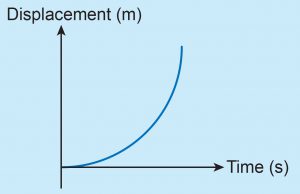Question 1:
Fill in the blanks with the correct answer.
(a) Free fall is the motion of an object due to ________ force only.
(b) The non-free fall motion of an object is affected by _________ resistance.
(c) __________ is the acceleration due to gravitational force acting on an object towards the centre of Earth.
Fill in the blanks with the correct answer.
(a) Free fall is the motion of an object due to ________ force only.
(b) The non-free fall motion of an object is affected by _________ resistance.
(c) __________ is the acceleration due to gravitational force acting on an object towards the centre of Earth.
Answer:
(a) gravitational
(b) air
(c) Gravitational acceleration
Question 2:
The graph below shows the free fall of an object.
The graph below shows the free fall of an object.

Explain the graph.
Answer:
• Before being released, the displacement of the object is zero. The object is stationary.
• At the moment the object is released, it moves with low velocity.
• This can be seen in the small value of gradient.
• In the final stage when the object is in free fall, it moves with velocity greater than at the initial stage.
• This can be seen in the greater value of gradient.